
Confused by the codes on a grinding wheel? Making the wrong choice costs money and ruins parts. Let me show you how to read them correctly, ensuring perfect results every time.
A grinding wheel is specified by a code representing its key features. This includes the abrasive type, grit size for finish, grade for hardness, structure for density, and bond type. Understanding this code ensures you choose the right wheel for precision, efficiency, and safety.

Choosing the right grinding wheel1 can feel like learning a new language. I’ve been in this business for nearly three decades here in Henan, the heart of China’s abrasive production. I’ve seen firsthand how a small mistake in wheel selection can lead to big problems on the production line. But once you understand the system, it becomes simple. This guide is based on my years of experience helping buyers like you get the exact tool they need for the job. Let’s break it down together so you can order with confidence and get the performance you expect.
What do the numbers and letters on a grinding wheel stand for?
That long string of characters on a wheel isn’t random. It can be intimidating, leading to guesswork and costly ordering mistakes. Let’s decode it together, simply and clearly.
The numbers and letters are a standardized marking system that tells you everything about the wheel’s composition. They specify, in order, the abrasive type, grit size, grade (hardness), structure, and the bond type holding it all together. It’s a recipe for performance.

At our factory, we produce thousands of wheels, and every single one has this "recipe" printed on it. It ensures that a purchasing manager in Germany gets the exact same performance as a technician in the United States. Let’s look at a common example: A 36 L 5 V. This code might look complex, but it’s a straightforward story about what the wheel does best.
Here is a simple breakdown:
| Position | Code Example | Meaning | What it Does |
|---|---|---|---|
| 1. Abrasive | A | Aluminum Oxide2 | The cutting material. ‘A’ is for steel. |
| 2. Grit Size | 36 | Coarse | The particle size. Lower numbers mean faster material removal. |
| 3. Grade | L | Medium | The wheel’s hardness. ‘L’ is a balanced grade, not too hard or soft. |
| 4. Structure | 5 | Medium Density | The spacing of the grit. ‘5’ offers a good balance of cutting and finish. |
| 5. Bond | V | Vitrified | The "glue". Vitrified is a hard, rigid bond for precision work. |
Think of it like this: the Abrasive is the blade, the Grit is how aggressive it cuts, the Grade is how long the blades stay sharp, the Structure provides chip clearance, and the Bond is the frame holding it together. Understanding this sequence is the first and most important step to mastering wheel selection. It removes all the guesswork and ensures you’re speaking the same language as the manufacturer.
How do you select the correct grinding wheel for a specific material?
Using the wrong wheel on a new material can be disastrous. It can burn the workpiece, glaze the wheel, or create a poor finish, wasting both time and resources.
To select the correct wheel, match its characteristics to the material’s properties. Use hard abrasives (like CBN) for hard ferrous metals and soft abrasives (like Aluminum Oxide) for softer steels. Generally, use a soft-grade wheel for hard materials and a hard-grade wheel for soft materials.

This is where the real skill comes in, and it’s a topic we discuss with our clients every day. The core principle sounds backward, but it makes perfect sense: Hard materials need soft wheels, and soft materials need hard wheels.
Why? When you grind a very hard material, like a hardened tool steel, the grinding grits get dull quickly. A soft-grade wheel will break down and release these dull grits, exposing fresh, sharp ones underneath. This self-sharpening action3 prevents burning and glazing. If you used a hard-grade wheel, the dull grits would be held in place, rubbing instead of cutting, generating heat and ruining the part.
Conversely, when grinding a soft material like aluminum, a hard-grade wheel is better. The material itself is not tough enough to dull the abrasive quickly, so you want a wheel that holds onto its sharp grits for as long as possible to maximize its life.
Here is a basic guide we use at our company, Reliable, to help our customers get started:
| Material to Grind | Recommended Abrasive | Recommended Grade (Hardness) |
|---|---|---|
| Hardened Tool Steels, Superalloys | Cubic Boron Nitride (CBN)4 | Soft to Medium (G – L) |
| General Carbon & Alloy Steels | Aluminum Oxide (A) | Medium (I – M) |
| Stainless Steel | White Aluminum Oxide | Soft to Medium (H – L) |
| Cast Iron, Aluminum, Brass | Silicon Carbide5 (C) | Medium to Hard (K – P) |
| Tungsten Carbide, Ceramics | Diamond6 (D) | Soft to Medium (H – L) |
This is just a starting point. The exact specification also depends on the amount of material you need to remove and the surface finish you require. This is where our decades of experience become a valuable resource for our B2B partners.
What is the meaning of grit, grade, and bond in a grinding wheel specification?
You hear the words grit, grade, and bond used all the time. But mixing them up can lead to ordering a wheel that looks right but performs poorly for your specific job.
Grit is the size of the abrasive particles, controlling the finish. Grade is the wheel’s hardness, or how well it holds the grit. Bond is the adhesive that holds the grit and grade together, defining the wheel’s overall strength and application.

These three elements work together to define the wheel’s personality. Getting them right is critical for performance. I’ve found the best way to remember them is to think about building a brick wall.
Grit: The Size of the Bricks
Grit refers to the actual size of the abrasive grains. It is specified by a number. A low number (like 24 or 36) means very large, coarse grains. A high number (like 180 or 240) means very small, fine grains.
- Coarse Grit (16-36): Use this for fast, heavy material removal. The finish will be rough. Think of it as "hogging" off material.
- Medium Grit (46-100): This is a general-purpose range, offering a balance between material removal and a decent surface finish.
- Fine Grit (120-600+): Use this for finishing, polishing, and when a precise, smooth surface is the goal.
Grade: The Strength of the Mortar
Grade is the "hardness" of the wheel. This is often misunderstood. It does not refer to the hardness of the abrasive grains, but to the strength of the bond holding them. It is specified by a letter from A (softest) to Z (hardest).
- Soft Grade (A-H): The bond is weak. Grains are released easily. Ideal for hard materials7 and tasks requiring a cool cut.
- Medium Grade (I-P): A versatile range for many common applications.
- Hard Grade (Q-Z): The bond is very strong. Grains are held for a long time. Ideal for soft materials8 and long wheel life.
Bond: The Type of Mortar
Bond is the adhesive material itself. It determines how the wheel will behave under speed, pressure, and heat.
- Vitrified (V): A glass-like bond. It’s strong, rigid, and unaffected by water or oil. Perfect for precision grinding but can be brittle. This is the most common bond type9.
- Resinoid (B): A synthetic resin bond. It’s tougher and less brittle than vitrified, making it excellent for high-speed cutting, rough grinding, and cutoff wheels.
- Rubber (R): A rubber bond provides the most flexibility and a very smooth finish. It’s often used for polishing or as the regulating wheel in centerless grinding.
Understanding these three components allows you to custom-tailor a wheel for virtually any grinding task.
What are the main types of grinding wheel abrasives and when should you use them?
Choosing the wrong abrasive material is an expensive mistake. It’s like trying to cut a steak with a butter knife; it simply won’t work and will ruin your tool.
The main abrasives are Aluminum Oxide for steels, Silicon Carbide for non-metals and non-ferrous alloys, and superabrasives like Diamond and CBN. Diamond is for carbide and ceramics, while CBN is the best choice for grinding hard ferrous metals like tool steel.

Here in Henan, we are at the center of China’s abrasive supply chain; 80% of the nation’s diamonds are produced in our province. This gives us deep expertise in selecting the perfect cutting material for any job. Your choice of abrasive is the foundation of your grinding operation.
Conventional Abrasives
These are the most common and cost-effective types.
- Aluminum Oxide (A): This is the workhorse of the industry. It’s tough and durable, making it the best choice for grinding materials with high tensile strength. This includes carbon steel, alloy steel, high-speed steel (HSS), and malleable iron. We often use White Aluminum Oxide (WA), a purer form, for grinding heat-sensitive steels because it cuts cooler.
- Silicon Carbide (C): This abrasive is harder and sharper than aluminum oxide, but also more brittle. Its sharpness makes it extremely effective on materials with low tensile strength. Use it for grinding gray cast iron, aluminum, brass, bronze, copper, as well as non-metallic materials like stone, rubber, and ceramics.
Superabrasives
These are used for materials that are too hard for conventional abrasives.
- Cubic Boron Nitride (CBN): CBN is the second-hardest material known, after diamond. Its key advantage is thermal stability with iron. This makes it the absolute best abrasive for grinding hardened ferrous materials. Use it for tool steels, die steels, case-hardened components, and aerospace superalloys. It provides a cool cut with exceptional precision on the hardest steels.
- Diamond (D): As the hardest material on Earth, diamond is the ultimate abrasive for grinding extremely hard materials. It excels at grinding tungsten carbide, industrial ceramics, glass, sapphire, and hard non-ferrous metals. Crucial note: Never use a diamond wheel to grind steel or other ferrous metals. The high heat of grinding causes a chemical reaction where the carbon in the diamond dissolves into the iron, causing rapid wheel wear.
By matching the right abrasive to your material, you ensure efficient cutting, superior finish, and longer wheel life.
Conclusion
Choosing the right grinding wheel requires understanding its specifications. This simple knowledge helps you get the right tool, saving money, reducing waste, and improving the quality of your finished parts.
-
Understanding the features of a grinding wheel is essential for selecting the right one for your needs. ↩
-
Aluminum Oxide is versatile and effective for various materials, making it a popular choice. ↩
-
Self-sharpening action helps maintain cutting efficiency, preventing overheating and damage. ↩
-
CBN is ideal for grinding hard ferrous metals, ensuring precision and longevity. ↩
-
Silicon Carbide excels in grinding non-ferrous materials, providing sharp and effective cutting. ↩
-
Diamond’s unmatched hardness makes it perfect for grinding extremely tough materials. ↩
-
Choosing the right wheel for hard materials prevents damage and ensures effective grinding. ↩
-
Using the correct wheel for soft materials maximizes efficiency and extends wheel life. ↩
-
The bond type affects the wheel’s strength and application, crucial for achieving desired results. ↩
Written by
leeon
You may also be interested in:
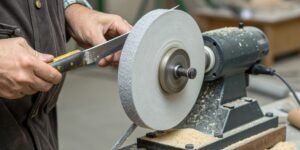
How to use a hard felt bench grinding wheel on knives?
Getting a razor-sharp, polished edge on a knife can be frustrating and slow. A dull knife is dangerous, and using the wrong tool can easily
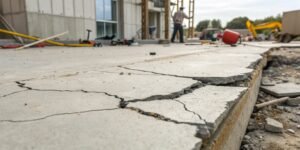
What are grinding cracks and how do you stop them?
Are tiny cracks appearing on your ground surfaces? This problem leads to part failure, wasting time and money. You can solve it by understanding the
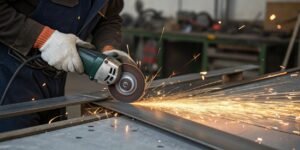
What does an angle grinder do that other tools can't?
Struggling with tools for multiple tasks? Carrying a heavy toolbox is inefficient. An angle grinder replaces many tools, saving you time and effort on the
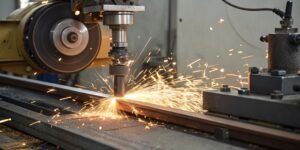
How to reduce the cycle time in a grinding machine?
Is your grinding process a major bottleneck? Slow cycle times hurt your bottom line and delay deliveries. You can speed up production by optimizing key

Do you regularly sharpen your chisels? If so, how?
A dull chisel ruins wood and causes frustration. This wastes time and expensive materials. Learning to sharpen correctly is the simple, game-changing solution you need
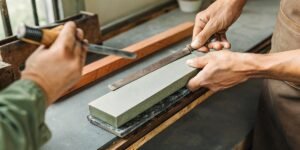
How to sharpen wood chisels by hand?
Dull chisels tear wood, ruin projects, and waste your time. Learning to sharpen them by hand restores their precision, making your work effortless and enjoyable
